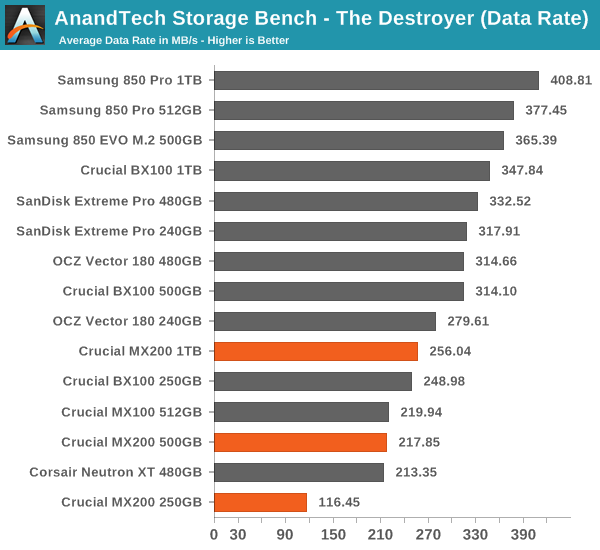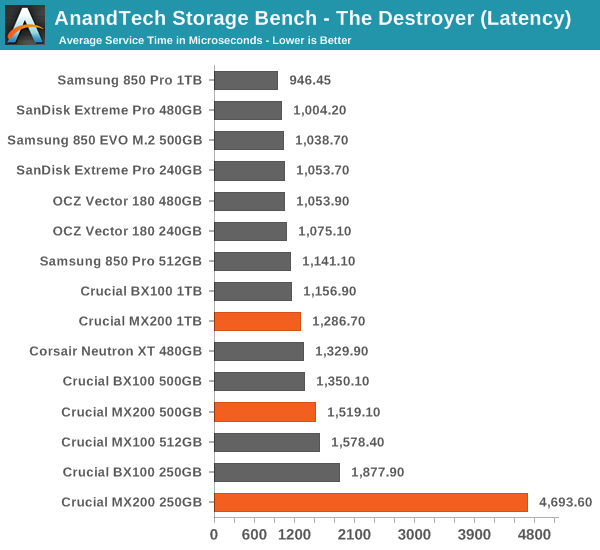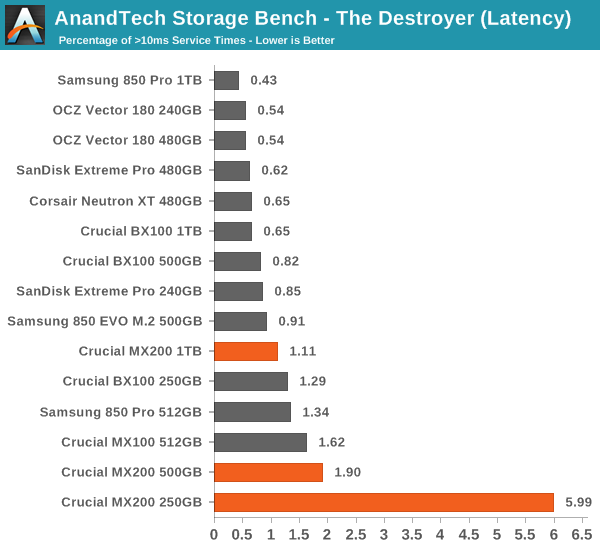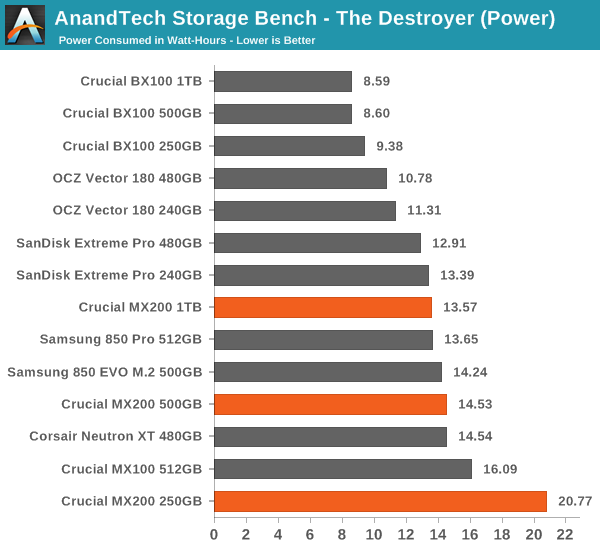Crucial MX200 (250GB, 500GB & 1TB) SSD Review
by Kristian Vättö on May 22, 2015 8:00 AM EST- Posted in
- Storage
- SSDs
- Crucial
- MX200
- Micron 16nm
AnandTech Storage Bench - The Destroyer
The Destroyer has been an essential part of our SSD test suite for nearly two years now. It was crafted to provide a benchmark for very IO intensive workloads, which is where you most often notice the difference between drives. It's not necessarily the most relevant test to an average user, but for anyone with a heavier IO workload The Destroyer should do a good job at characterizing performance. For full details of this test, please refer to this article.

Despite the improved IO consistency, the MX200 doesn't have any advantage over the MX100 in our heaviest The Destroyer trace. The MX200 is clearly not crafted for intensive IO workloads because there are far better drives available, which is a shame because I've been waiting for Crucial to deliver a true high-end drive, but the MX200 clearly isn't that. What's alarming is the fact that the BX100 is actually faster than the MX200, which doesn't speak too highly of Crucial-Micron's custom firmware for the Marvell controller.

Average latency doesn't really change the story as the MX200 is still a relatively slow drive by today's high-end SSD standards. Especially the performance of the 250GB is surprisingly bad and it looks like Crucial's SLC cache implementation isn't optimal for intensive IO workloads.

The share of high latency IOs is also pretty bad, although fortunately even the 250GB model manages to keep +100ms IOs within a reasonable limit.

The power consumption is quite average, but the BX100 is without a doubt far more power efficient even for high intensity IO workloads despite its position as a value drive.











62 Comments
View All Comments
KAlmquist - Saturday, May 23, 2015 - link
Take another look at Anandtech Bench. At the 500GB capacity, the mx100 beats the m550 by a small amount across the board. Dropping down to the 250GB capacity affects the write speed of the mx100 more than the write speed of the m550, so the m550 outperforms the mx100 on some benchmarks, but not by a lot. The bottom line is that the m550 and mx100 are close enough in performance that I doubt you would notice any difference in real life usage.petar_b - Sunday, September 4, 2016 - link
I wish I know the answer to that question. I use plenty of M500 and M500, and I really miss them. I don't know if SanDisk could be decent alternative to M550, I don't know how additional features compare to each other (power loss, power management, etc etc). Is there any comprehensive comparison between Micron and SanDisk ??Devo2007 - Friday, May 22, 2015 - link
Small typo on page 3. Under the Destroyer (Data Rate) graph, it says the following:Despite the improved IO consistency, the MX200 doesn't have any advantage over the MX200 in our heaviest The Destroyer trace."
I'm not sure if you meant MX100 or BX100 the second time
XZerg - Friday, May 22, 2015 - link
same on the page 10 under the power consumption chart:but at ~60mW the MX200 enjoys a small benefit over the MX200
Ryan Smith - Friday, May 22, 2015 - link
Thanks. Fixed.Essence_of_War - Friday, May 22, 2015 - link
Yikes, not at all impressed with the DWA in the benchmark workloads! It seems like DWA is a highly dubious feature for a price mark-up over the BX series. At the right price point the larger capacity MX200 w/o DWA (500 and 1TB) still seem like excellent buys, they're just competing super-hard with their BX brethren.olafgarten - Friday, May 22, 2015 - link
I'm still waiting to see what SanDisk does this year.romrunning - Friday, May 22, 2015 - link
Thanks for the good review, Kristian. I liked the call-out on the continued lack of full power-loss protection, and I really liked the constructive criticism in your final words.Shadowmaster625 - Friday, May 22, 2015 - link
why would they even release a product with an slc cache when the slc cache clearly does absolutely nothing?hulu - Friday, May 22, 2015 - link
I'm sure the cache does *something* - mostly when you don't write large amounts of data for minutes on end.The problem with MX200 256GB's implementation is that Crucial is using too much of pseudo-SLC (all the space there is) and the drive ends up driving itself against the wall when the drive fills up. The drive still needs to keep up with the continuing drive writes and at the same time move existing data from SLC to MLC.